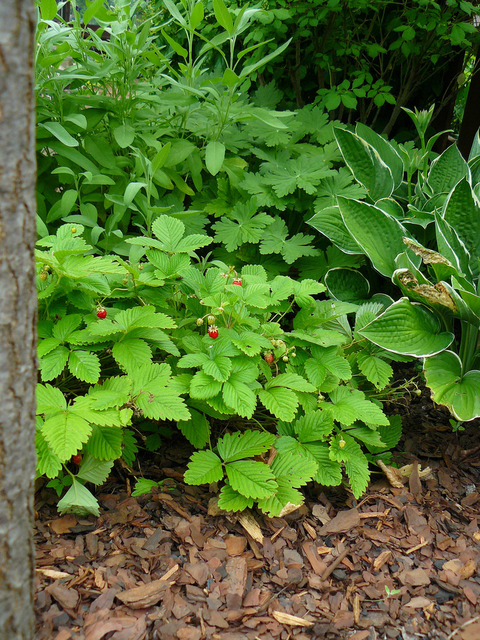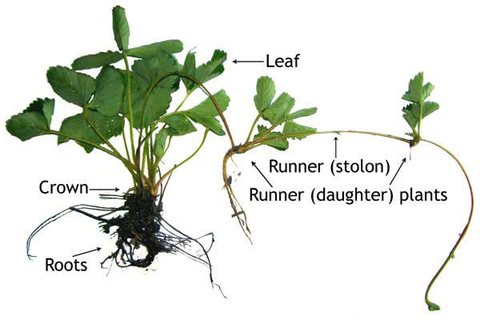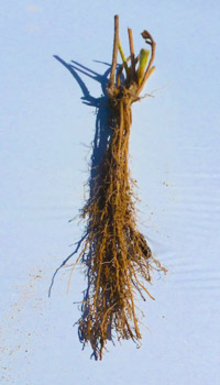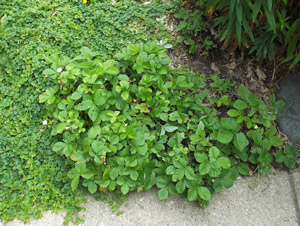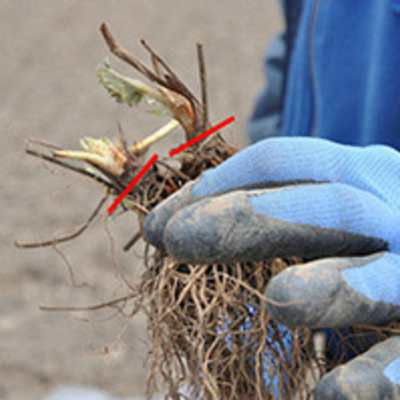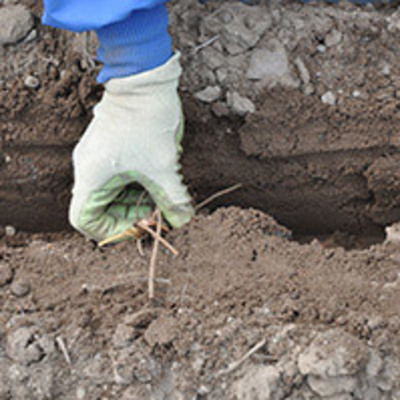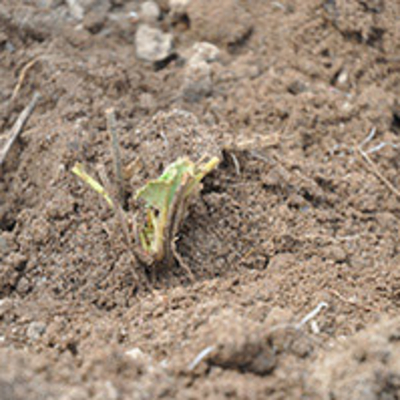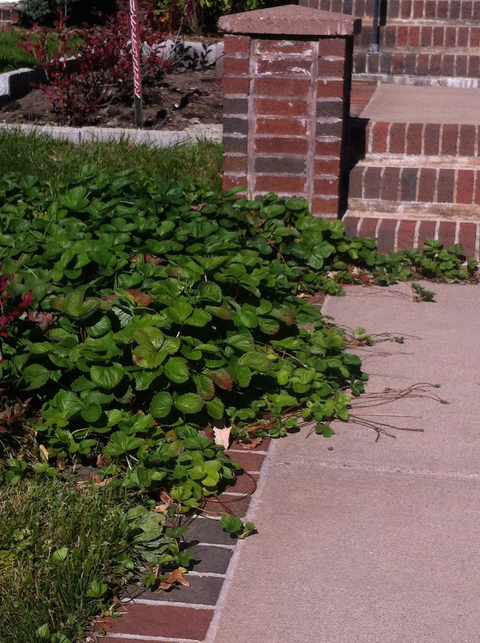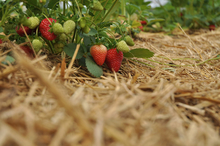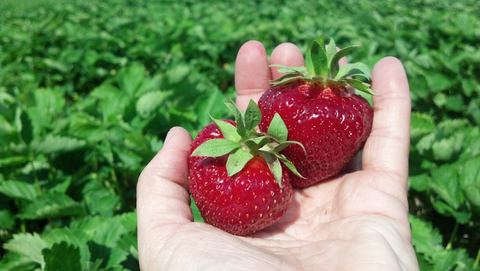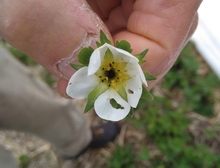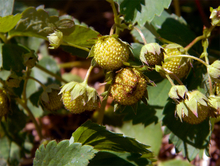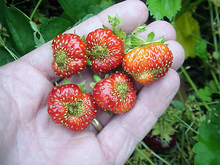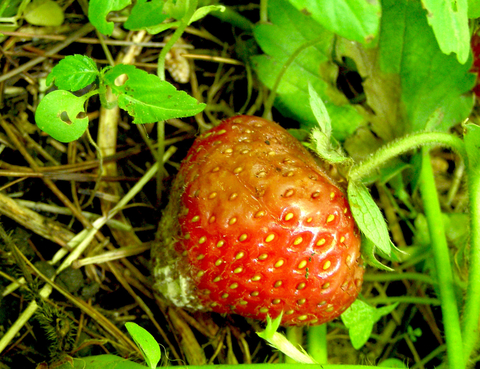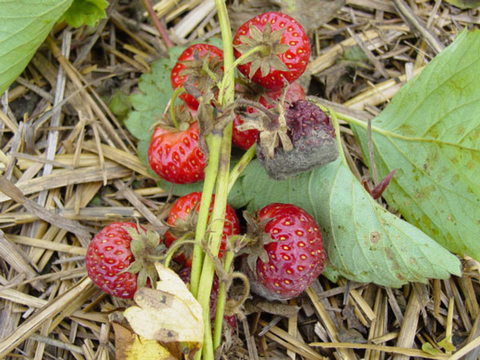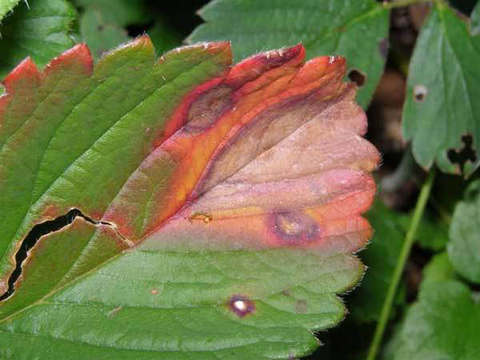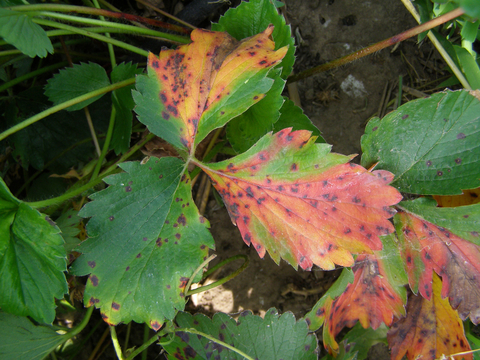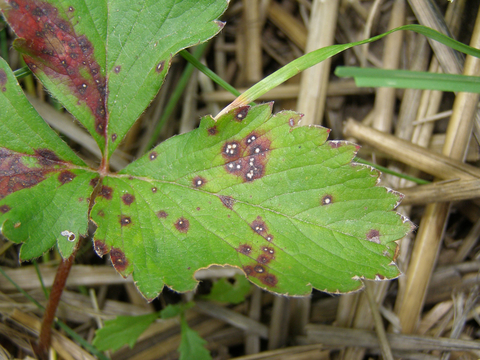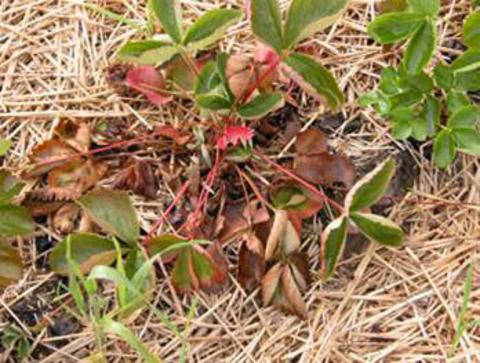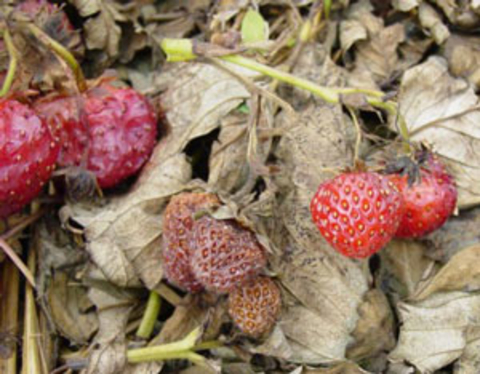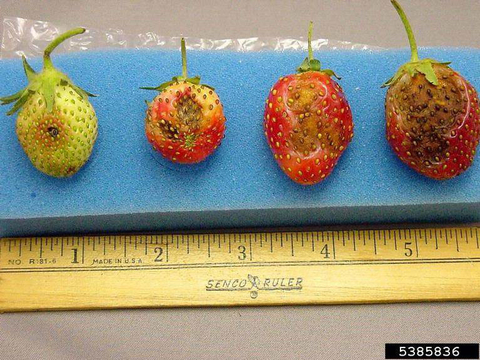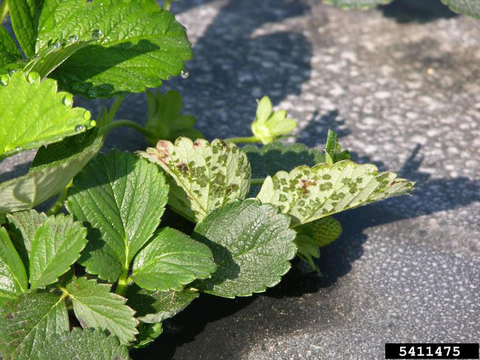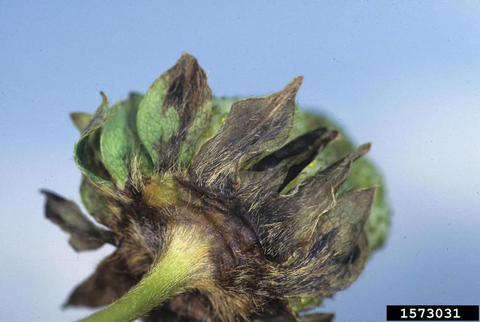Quick facts
-
Strawberries need full sun to produce maximum fruit.
- Space plants 12 to 18 inches apart.
- Strawberries are self-fertile, but require bees for pollination.
- Remove some of the runners throughout the season or your strawberry plants will take over your yard.
- After removing flowers for a few weeks after planting, you can pick fruit later that summer.
- One June-bearing plant can produce up to 120 new daughter plants in one season.
Types of strawberries
There are three types of strawberries available to the home gardener.
- June-bearing strawberries produce a large, concentrated crop in mid-June to early July.
- Ever-bearing types produce two crops, one in early summer and the second in early fall.
- Day neutral plants produce fruit throughout most of the growing season.
Of the three types, June-bearing strawberries normally produce the largest yield per season, but in a short period of time.
Strawberry plants usually begin flowering in mid-May in southern Minnesota. For June-bearing varieties it takes about four weeks from plants flowering to picking fruit.
Day neutral and ever-bearing types begin flowering around the same time in the spring and take about the same time between flowering and harvest. The difference is that they keep flowering through the summer months.
In addition to leaves, flowers and fruit, a strawberry plant has a crown, roots, runners and produces daughter plants.
The woodland strawberry
The woodland strawberry (Fragaria vesca) is a day neutral strawberry species. You might also see it called alpine strawberry, fraises des bois, wild strawberry or European strawberry. The plants produce small, sweet fruit with maybe two to three berries per plant per week.
Because many of these plants are grown from seed, the plants can either produce runners or not. They tolerate shadier sites and can be planted in the front of perennial beds, walkways or in containers.
Follow this calendar to keep strawberries healthy and productive
| What to do | When to do it |
|---|---|
| Rake straw away as plants start to grow, leaving a little straw to protect them | April |
| Plant dormant transplants | April, May |
| Plant potted transplants | May, June |
| Pinch flower buds off transplants for a few weeks | May |
| Thin June-bearing plants within two weeks after harvest | July |
| Apply compost to day neutral plants if needed | July, August |
| Remove runners from June-bearing plants as needed | July through October |
| Cover plants with straw mulch if overwintering | November |
Choosing strawberry plants
Many strawberry varieties are available and can be grown with ease in home gardens. Some taste better than others. Some are more winter hardy than others. Some ripen in one small window in June, while others produce fruit throughout the growing season.
These varieties were chosen mainly for flavor and, when mulched, they are winter hardy in USDA Zone 4.
USDA Zone 3 is much colder and plants need additional cover to survive temperature extremes without snow cover.
Although most garden centers sell strawberry plants in spring, many of the varieties listed here are commonly available only from mail-order sources. You can find nurseries online that carry the ones you'd like to plant.
| Variety | Type | Hardiness (zone 4 to zone 3) | Description |
|---|---|---|---|
| Annapolis | June-bearing | Good to poor | Vigorous plants produce medium-large fruit with mild, sweet flavor. Produces many runners. |
| Earliglow | June-bearing | Fair to poor | Firm, glossy fruit with classic strawberry flavor. Some disease resistance. Vigorous. Great variety for beginners. |
| Jewel | June-bearing | Good to poor | Firm, glossy fruit with excellent flavor. Tolerates molds and rots. Heavy producer. |
| Honeoye | June-bearing | Excellent to very good | Very productive. Aromatic, large, glossy, crimson berries with excellent flavor. Disease resistant and easy to grow. |
| Cavendish | June-bearing | Excellent to very good | Ripens over a long season. Produces large berries with very good flavor. Prolific runners. |
| Ogallala | Ever-bearing | Excellent to very good | Vigorous plants produce soft, deep red, rich-flavored berries. Drought tolerant. |
| Seascape | Day neutral | Very good to poor | Productive from early summer through fall. Bright red berries inside and out. Disease resistant. Great for containers and garden beds. |
| Albion | Day neutral | Fair to poor | Medium, firm berries have excellent flavor. Produces consistently from June until frost. Great for containers or in the garden. |
| Alpine strawberry | Day neutral | Excellent to good | Not a variety but a different type/species of strawberry. Grows well in part shade. Does not produce runners, so plants remain small. |
Planting and caring for young plants
Strawberries require sun to produce fruit. Ten or more hours of sunlight each day is ideal,but they need a minimum of six hours of direct sunlight each day.
Before planting, a soil test will help you find out if you need to add any nutrients to your soil.
It's a good idea to work some well-rotted compost into the soil before planting. Compost helps add nutrients to the soil, improves drainage and increases microbial activity, all of which will benefit the plants.
Although most garden centers sell strawberry plants in spring, many of the best varieties for Minnesota are available only from online or mail-order sources.
- Nurseries generally ship dormant, bare root plants at the appropriate time for planting in your region. The plants arrive looking small and brown; they have not started growing yet.
- Keep the plants moist and cool, and plant them as soon as possible.
- You will see fresh green growth appearing within a week or so.
- If you buy potted plants from a garden center, look for vigorous plants without any discolored or dead leaves.
- Keep the soil in the pot moist until planting.
Site selection
By choosing the right site to grow strawberries, you can lower disease and insect pest pressure.
- Choose a site located away from trees and buildings that cast shade for more than a few hours each day.
- Trees will compete for water and nutrients as well as cast shade, so the strawberry bed should lay beyond the root zone of large trees. The root zone is roughly the same size as the canopy of a tree.
- Strawberries should be planted in well-drained soil that does not accumulate standing water following a heavy rainstorm.
- Planting on higher ground minimizes frost damage, while increasing air circulation around the strawberry plants.
- Good air circulation allows the berries to dry out faster, reducing the incidence of some diseases.
Plant spacing
If planting a large number of strawberries plant in rows. This makes it easier to control weeds, runners and pests.
There are many methods of row planting that work well for strawberries, but by far the most common method is the matted row system:
- Space plants 18 to 24 inches apart
- Space rows 3 to 4 feet apart
June-bearing plants especially will send out many runners throughout the season and fill in the space between plants, so it's important to go with the recommended spacing, otherwise your plants will quickly become overcrowded.
Strawberries in the landscape
Strawberries don't need to be planted in rows when incorporated into the home landscape.
Day neutral types work well at the front of a perennial border or along a sidewalk or driveway. Because they produce fewer runners than June-bearing types, maintenance is minimal.
Strawberry plants may also be grown as a ground cover.
- To grow a strawberry ground cover, space the mother plants in a grid, either 1 x 1 foot or 2 x 2 feet.
- The planting will require regular weeding, especially in the first year, but maintenance should be minimal after the plants are established.
- Strawberries grown as a ground cover may not produce quite as much fruit as those grown in rows, but the plants will add a beautiful touch to your landscape.
Planting depth
Plant dormant strawberry transplants in spring as soon as the soil is warm enough to easily get a trowel into it. Potted plants should be planted soon after purchase, after risk of frost is past.
It is important to plant dormant transplants at the right depth.
- If the crowns are planted too shallow they lose water and can die.
- If the crowns are planted too deeply the leaves may not be able to emerge from the soil.
- If planting a growing plant bought from a nursery or garden center, simply plant at the same depth the plant was in the container.
Dormant transplants have no growth, but sprout quickly when exposed to light and warm temperatures. Plant center of the crown (red line) at the soil line with the roots fully buried and growth visible.
Transplants can be planted into a trench as seen here, or into holes dug for each plant.
This transplant has been planted at the proper depth. The roots are fully below the soil line and the growth points are visible above the soil.
- After planting, firm the soil around the plant and water thoroughly.
- Strawberries perform best when they are given the equivalent of 1 inch of rainwater per week.
- Use a rain gauge to monitor rainfall and water with a soaker hose or drip system if needed.
- One good soaking each week should be enough in most soil types.
- Always water early in the day so that leaves have a chance to dry before nightfall. This will help prevent leaf diseases.
How to keep strawberries healthy and productive
Spring of planting year
After planting, pinch off any flower buds that appear for the first few weeks. This allows the plant to produce leaves and roots so when the flowers are pollinated and begin to produce fruit there is enough energy in the plant to develop large, juicy strawberries.
Summer
As runners begin to appear, place them where you want the plants to fill in and gently press the end of the runner into the soil. This will encourage the daughter plant to root where you want it to. If the plants are running too much, simply cut them off with a scissors or pruning shears.
After harvest
- Continue to water plants.
- Thin out plants, leaving remaining plants about 6 to 8 inches apart.
- Remove older, woody plants and leave the younger plants for next year.
- Fertilize with compost around the plants to keep them growing through the season.
Day neutral plants flower and fruit throughout the summer. If plants are not growing well, applying compost along the side of the plants will give them a boost of nitrogen. Other organic fertilizers such as blood meal can be used too.
Fall
June-bearing strawberry plants continue to grow and produce runners until the frost kills the leaves. Keep removing runner plants if there is a lot of crowding.
After the plants have entered dormancy due to cold temperatures, and the temperatures are staying below 40°F, straw mulch should be applied about 4 to 6 inches over the top of the plants. This mulch will protect the plants from extreme winter cold so they will emerge again next spring.
Most day neutral varieties are not quite hardy enough to over-winter in Minnesota, but it may be worth a try. Cover these with straw just as you would June-bearing plants.
Winter
Winter is the time strawberry plants will rest, so there isn't much for you to do. A good snow cover on top of the straw mulch will help insulate the plants from bitter cold temperatures, so enjoy watching that snow pile up!
After raking straw mulch off in the spring, keep the straw mulch between and under plants to help retain soil moisture, prevent weeds, and give the berries a nice clean surface on which to ripen.
Spring of the second year and beyond
Straw mulch applied to protect plants from winter cold should be removed when the snow and ice melts completely.
This winter mulch makes a great summer mulch too. Rake the straw off the plants and leave it between them to help conserve water and keep weeds down as the temperatures begin to rise.
Fertilizing
- If June-bearing plants do not produce many runners by mid-July this usually means the plants need more nitrogen.
- You can apply compost or an organic fertilizer, such as blood meal, around the plants to increase nitrogen for plant growth.
- Before plants begin to grow in the spring of the second year, you may need to add more compost or organic nitrogen to encourage plant growth and fruit development.
Weeding
- Because strawberries are poor competitors, keep all weeds out of the strawberry bed.
- Hand-weeding is recommended for home gardeners.
- Careful cultivation with a hoe is effective for managing weeds in strawberry plantings, but be careful not to dig too deeply, as you could damage the plant's shallow root system.
Harvest and storage
Strawberries ripen from the tip towards the leafy stem end. Some varieties have "white shoulders" because the leaves cover the fruit and do not allow for the red color to develop. But most will be completely red when ripe. They might not all be large, but a deep red, homegrown strawberry will always have a big flavor.
Look through the plants daily once you see the red color developing and harvest ripe fruit.
Strawberries do not store for very long in the refrigerator. For best results, pick the fruit when it is dry and place fruit in refrigerator immediately. This will help extend the storage life of the berries.
Winter protection
The crown of a strawberry plant may be killed at 15°F, therefore winter protection is essential.
- After 2 or 3 frosts have hardened off the plants, cover them with 4 to 6 inches of weed-free straw
- Straw is especially valuable in late fall or early spring when bitter cold temperatures might occur without snow cover
- Snow is an excellent insulator and will be sufficient protection where snow cover is reliable
Rake straw away in spring when growth begins, but leave some at the base of the plants to act as the summer mulch.
If frost is predicted after flowering begins, either re-cover the plants with straw or protect them with spun-bonded polyester fabric row covers.
- Renovation helps control diseases and insect pests by disrupting their life cycles.
- Regardless of the size and shape of your strawberry patch it is best to mow or cut the foliage back before August 1.
- A new canopy will develop by mid-August.
First, mow plants and remove clippings.
This helps to control diseases by removing older leaves that are infected by leaf spot or fruit rot pathogens. This helps to control insects by removing their food source and potential breeding sites.
Thin rows
If plants are grown in rows, renovation is a good time to thin widening rows back to their original width. This will improve airflow through the patch and reduce the time that the leaf surfaces are wet, which can reduce disease severity.
To have a good crop in the following year requires healthy thriving plants from post-renovation to dormancy in the fall. Pay attention to the health of your plants in this time period.
Managing pests and disorders
Gardeners need to be able to identify pests and the damage that they cause in order to choose the best way to manage them.
You can find additional help identifying common pest problems by using the online diagnostic tools What insect is this? and What's wrong with my plant? or by sending a sample to the UMN Plant Disease Diagnostic Clinic.
For detailed management strategies for specific insects and diseases see Pest management for the home strawberry patch.
| What to do | When to do it |
|---|---|
| Protect strawberry flower buds from spring frosts. Do not remove straw mulch used for winter protection until there is no longer a threat of frost, around when lilac buds begin to open. | Early spring |
| Leave mulch in the alleyways. To reduce spread of diseases from soil to fruit and leaves, add straw mulch around plants and in alleyways if remaining winter straw mulch is less than 2 inches deep. | Early spring |
| If gray mold was a problem the previous year, completely remove all straw mulch from the bed and replace with new straw. | Early spring |
| Use mulch to recover flowers if a frost is predicted. | Early spring |
| Do not apply nitrogen in spring. It can produce too much young leaf tissue susceptible to leaf-disease fungi. | Early spring |
| Look for clipped buds that could mean strawberry bud weevil activity. | Before strawberry flowers bloom |
| Look for Tarnished plant bug adults when flower buds are green or white. | Before strawberry flowers bloom |
| If gray mold has been a problem in the past, and high humidity or frequent rain during bloom is predicted, spray flowers with fungicide beginning when 10% of the flowers open and repeating once after the time period specified on the label. | Before strawberry flowers bloom |
| Set out traps for spotted wing Drosophila. | Strawberry flowers are in full bloom |
| Inspect for slugs. Apply baits if damage is detected. | Strawberries are ripe |
| Harvest fruit as it ripens to help protect against sap beetles and spotted wing Drosophila; remove and dispose of overripe fruit. | Strawberries are ripe |
| Take care not to wound or bruise berries during harvest. | Strawberries are ripe |
| Remove berries infected with fruit rot to prevent spread of disease to ripening fruit. Do not place healthy fruit and diseased fruit into the same container. | Strawberries are ripe |
| Renovate in the two weeks following harvest. | After harvest |
| Rake up and remove all leaf debris from the bed after renovation. | After harvest |
| Apply nitrogen fertilizers. | After harvest |
| Apply straw that is free of weed seeds two to three inches deep over the plants after they have been subjected to several sharp freezes in the low 30s or high 20s. | Fall |
To produce healthy plants, avoid situations that favor the development of diseases or contribute to insect infestations.
Watering
- When watering plants, avoid getting the leaf surfaces wet by using a drip system or a soaker hose.
- If a sprinkler system is used, water plants in the mornings on a sunny day to allow leaf surfaces to dry quickly, to reduce fungal diseases.
Site rotation
- Land that has been planted in strawberries for 4 years or more can build up a population of root-rotting diseases.
- If possible, move strawberry plants to different areas of the garden every 3 to 4 years.
Winter injury
- Straw mulch reduces winter injury and plants that have less winter injury have reduced disease.
- Straw mulch is important in the spring and summer to reduce fruit and flower diseases by covering the soil and reducing spore movement carried by raindrop splash.
- When removing straw in spring, leave 1/2 to 1 inch of straw between rows to keep fruit off the soil and reduce weeds.
There are many different insect pests of strawberries. Some of these pests will be present every year, and some you will never see.
Most insect damage can be reduced by following the best practices mentioned above and:
- Remove leaf litter to reduce the number of insect overwintering sites.
- Remove weeds and keep lawns mowed as they can provide habitat for adults to feed and overwinter.
- Renovate the patch to remove potential habitat and reduce insect numbers.
- Frequently harvest crops to ensure ripe fruits are not in gardens for too long.
- Remove and destroy any old fruit that remains on stems or that has fallen to the ground.
The most common insect pests of strawberries in Minnesota are tarnished plant bugs, strawberry bud weevils, slugs and flower thrips.
- The tarnished plant bug feeds on developing flowers, causing deformed berries.
- The strawberry clipper clips off flower buds in spring, thus reducing harvest.
- Slugs feed on ripe fruit, leaving small, deep holes in the fruit and irregular holes in foliage.
- Feeding by thrips causes berries to appear bronzed and seedy.
- Spotted wing drosophila is a particular problem of ever-bearing strawberries and other soft fruits in Minnesota.
Wildlife
Rodents and birds may cause more trouble in home strawberry plantings than insects. Large holes in ripe fruit are a good sign that these creatures are enjoying your strawberries. Pick fruit as soon as it is ripe to prevent damage.
Frost during bloom can cause strawberries to be deformed and undersized as it ripens. Damaged fruit is still edible.
Frost damage is easily mistaken for tarnished plant bug (TPB) damage. Both cause puckering and concentrations of seeds on parts of the berries, as the damaged part grows more slowly than the rest of the berry. However, frost damage has a less predictable injury pattern, while TPB injury causes puckering or “cat facing” at the tip of the berry.
Tips for distinguishing frost damage from TPB damage:
- Frost damage appears randomly over the fruit. TPB damage is concentrated at the tip of the berry.
- If only one berry on a cluster is damaged, then it is more likely due to frost damage. TPB often feed on multiple berries per cluster.
- Consider the bud stage of the plants during the last frost. The more developed the blossoms were, the higher the risk of frost damage.
- Consider whether you noticed blossoms with black centers after the frost. This is a sign of frost damage.
Diseases of strawberries
Strawberries are susceptible to fruit rots and leaf diseases. Fungi causing fruit rots infect the flowers and fruit as early as bloom time. Leaf diseases often have little effect on plant growth.
To keep fungi to a minimum:
- Plant in full sun.
- Keep plants from being crowded.
- Water early in the day to reduce the amount of water on the flowers and fruit.
- Use straw mulch under the plants.
Identify and manage fungal diseases
Gray mold, leaf blight, leaf scorch and leaf spot are caused by different fungi, but are managed mostly in the same way.
Choose sites with full sun, good soil drainage and air circulation. Fungi require long periods of continuous wetness to infect plants. Any practice that promotes quick drying of leaves and fruit will reduce disease.
- Remove weeds to improve air circulation around plants.
- Plant in rows or narrow beds, no wider than 12-18 inches, to promote good air movement in and around plants. Patches grow with time as new runners are produced. Use renovation to maintain narrow beds.
- Renovate strawberry beds every year after harvest.
- Following renovation, rake and remove old leaves.
- Irrigate with drip irrigation or a soaker hose. If overhead sprinkling is your only option, water early in the morning on a sunny day so leaves dry quickly after irrigation.
- Apply nitrogen fertilizers after renovation. Avoid early spring applications of nitrogen which encourage overly lush growth that reduces airflow and promotes a moist microclimate optimal for the growth of fungal diseases.
- Fungicides are either not necessary or not available to home growers to control these diseases.
- Cultural control practices usually reduce disease to a manageable level.
Gray mold
Gray mold (Botrytis cinerea) is the most common fruit rot disease of strawberries in Minnesota. The disease is most prevalent when there is prolonged cool, wet weather during flowering.
- The gray mold fungus overwinters on dead strawberry leaves, infected straw, mummified fruit and weeds.
- Infection is most severe in rainy or humid conditions where flowers remain wet for more than 12 hours.
- Can begin anywhere on the fruit but is most common on the stem end, where the fruit comes in contact with infected flower parts or anywhere the fruit is touched by another infected berry.
- Infections may attack blossoms, which then do not develop into fruit.
- More commonly, infections grow in the young fruit and remain dormant until the fruit begins to ripen.
- The fungus rots the fruit and produces powdery, gray spores on the surface of the fruit.
- Rot spreads to adjoining berries wherever the healthy and rotten fruit touch.
- Fruit remain attached to the plant but dry down to a shriveled mummified berry.
- New spores are produced on mummy berries during wet weather.
- The gray mold will colonize young leaves and remain dormant within them.
- When leaves die naturally, they can become an important source of gray mold spores in the strawberry patch.
- Plants damaged by winter injury may develop Botrytis crown rot, where leaf and flower stems rot and turn brown at the point where they attach to the crown of the plant.
Management
-
Honeoye is the only variety recommended in Minnesota that has shown partial resistance to gray mold.
- In patches with a history of gray mold, remove and discard all straw in early spring approximately when lilac flower buds appear.
- Place fresh straw or other organic mulch between beds to reduce rain splash and weeds and improve air movement around berries.
- Avoid wounding plants. Wounds facilitate entry of the disease.
- See more on how to manage this disease above.
Harvest recommendations
- Harvest frequently and remove infected fruit from the field throughout the harvest season.
- Take care to keep diseased fruit separate from healthy fruit as gray mold can spread rapidly even after harvest.
- Handle berries with care and refrigerate soon after picking.
Fungicides
Fungicides may be needed to protect fruit from gray mold fruit rot in years where rainy wet weather persists while plants are in bloom. In this case, fungicides should be applied during blossom to prevent fruit rot.
Read and follow all label instructions. If the season is one characterized by prolonged periods of wet or humid weather, continue spraying at the interval described on the fungicide label until petal drop.
If possible watch the weather and spray before rain is predicted. Fungicides with copper or Captan as active ingredients will reduce gray mold fruit rot in strawberry when applied properly. Fungicide sprays applied to green fruit and during fruit harvest do little to reduce disease and are not recommended.
CAUTION: Mention of a pesticide or use of a pesticide label is for educational purposes only. Always follow the pesticide label directions attached to the pesticide container you are using. Remember, the label is the law.
Be sure that the plant you wish to treat is listed on the label of the pesticide you intend to use. Also be sure to observe the number of days between pesticide application and when you can harvest your crop.
Leaf blight
- The leaf blight fungus (Phomopsis obscurans) infects all green parts of the plant and rarely causes a soft rot on ripening and ripe fruit.
- Leaves are most severely infected in shaded patches that have heavy dew or in years with frequent rain.
- This fungus requires long periods of continuous wetness to infect plants.
- Any practice that promotes quick drying of leaves and fruit will reduce disease.
Symptoms
- Solid reddish-purple spots on leaves.
- Spots develop tan center as they grow.
- Spots enlarge to V-shaped lesions with dry brown centers and reddish-purple borders.
- Severe infection can turn whole leaf brown.
- Black specks produce fungus spores.
- Reddish-purple spots can appear on stems.
- Mushy pink spots on fruit become dark brown and dry.
See above for how to manage this disease.
Leaf scorch
- In addition to leaves, leaf scorch (Diplocarpon earlianum) can infect petioles, runners, fruit stalks and berry caps.
- If unchecked, plants can be significantly weakened reducing the growth of all plant parts.
- Severely infected plants are weakened and can die from other stresses such as drought or extreme temperatures.
- The leaf scorch fungus overwinters on infected leaves and on leaf debris within the patch.
- The fungus can remain dormant for long periods in dry leaves, but it produces spores quickly in the presence of moisture.
- Spores are spread by wind or by splashing water. Spores will germinate and new leaf spots will form if leaves remain wet for 12 hours or longer.
- Once mature, leaf spots will produce spores throughout the growing season in response to wet conditions. These spores are spread mainly by splashing water.
- Hot dry weather halts disease progress.
- Severe infection in summer and fall can mean fewer strawberries the following year.
- Infections on fruit and flower stalks can girdle the stalk and kill the fruit and flower.
Symptoms
- Dark purple, angular to round spots appear on the upper surface of the leaf.
- As the disease progresses the tissues around these spots turn reddish or purple.
- In severe cases, the infected area dries to a tan color and the leaf curls upward-looking scorched.
- Lesions remain reddish-purple and do not turn tan or gray in the center.
See above for how to manage this disease.
Leaf spot
- Leaf spot (Mycosphaerella fragariae) was once one of the most common and destructive fungal diseases of strawberry.
- Severe infection on susceptible varieties can result in the death of leaflets and the defoliation of plants.
- Many new strawberry varieties have resistance to leaf spot and the disease is no longer as common or as problematic as it once was.
- The leaf spot fungus can infect leaves, petioles, runners, fruit stalks, berry caps and fruit.
- The fungus overwinters on infected living leaves and in leaf debris.
- Spores are produced in the spring and spread to healthy tissue by splashing rain or irrigation.
- Cool temperatures (68 to 77 F) and long periods of leaf wetness (more than 12 hours) are required for new infections to develop.
- Consecutive wet days with temperatures between 50 and 86 F favor disease development.
- The disease will progress as long as temperature and moisture are in acceptable ranges.
- Many strawberries commonly grown in Minnesota can tolerate some leaf spot infection.
- Although leaf spots may be observed on foliage, the damage is typically not severe enough to reduce yield.
Symptoms
- Small purple spots on leaves or stems.
- The centers of leaf spots turn gray and then white with age.
- As the disease progresses multiple leaf spots merge together creating a reddish purple area with multiple round white centers.
- In severe cases, the leaves turn brown and die.
- Fruit infections are not common, but appear as small, sunken, leathery, black spots on unripe and ripe fruit.
- Seeds within the infected area of the fruit turn black.
See above for how to manage this disease.
Strawberry black root rot, or BRR, is the most common root disease in Minnesota.
This disease is a complex problem involving several different pathogens (Rhizoctonia fragariae, Pythium spp., Fusarium spp.) along with a variety of plant stresses such as winter injury. It is common in older strawberry patches or patches stressed by poor growing conditions like soil compaction or poor drainage.
Plants infected with BRR decline overtime, producing significantly lower yields than uninfected plants.
- Disease develops when plants are:
- Stressed by drought, water-logged soils, winter injury, poor nutrition, and root feeding by lesion nematodes (Pratylenchus penetrans) or insects; and
- One or more of the black root rot fungi, Pythium spp., Rhizoctonia spp., and Fusarium spp., are found in soils.
- Root tips and young feeder roots may be completely rotten and fall off.
- Infection in older roots is limited to the outer tissues of the root, leaving a white core that is unaffected.
Symptoms
The first symptoms of BRR are often missed. Infected plants have poor growth and produce fewer and smaller fruit. As the disease becomes more severe, plants are clearly stunted.
- Plants may wilt and the edges of leaves turn brown or have a 'scorched' appearance.
- Plants continue to decline and often die after the high stress of fruit production.
- In larger patches, disease often starts in low lying areas or areas with poor drainage. Each year the area of infected plants expands.
- Plants with BRR are often described as 'rat tail' because most of the finer feeder roots are rotted away leaving only the thick anchor roots.
- The remaining young roots have random gray to reddish brown sunken blotches. These lesions can expand to cover large areas of the root.
- The infected roots are soft and mushy. When touched, the outer layer often falls away, leaving only a thin strand from the core of the root.
Plants displaying the above symptoms should be carefully dug up and washed, keeping intact as much of the root system as possible. A healthy plant will have young roots that are creamy white with multiple fine root hairs and older roots will have a dark brown to black woody outside layer but a white interior.
Management
Prevention of black root rot is based on good site selection and proper plant care.
- There are no strawberry varieties that are resistant to black root rot.
- Choose a variety that is hardy in Minnesota to reduce winter injury and stress on the plant.
- Purchase new plants from a reputable supplier. Roots of young strawberry plants should be white and fleshy.
- For new patches, choose a location where strawberries have not been present for the past 2-4 years.
- Choose a location with good drainage or improve drainage before planting through adding organic matter to soil and redirecting water away from the area.
- Strawberries can also be planted on raised beds where drainage creates a soil environment less favorable to some root rotting fungi.
- Add organic matter like high quality compost, peat or straw to the soil prior to planting. This will improve drainage and encourage growth of beneficial microorganisms in the soil.
- Use a soil test to determine optimum fertilizer applications for the site.
- Renovate patches of June-bearing strawberries each year after harvest to maintain a healthy growing patch.
- To avoid winter injury, apply two to three inches of straw in the fall after several frost events below 20 F and above 30 F.
- In existing patches with black root rot, consider starting with new plants in a new location. Do not relocate old plants to the new location as the BRR pathogens will be carried on the roots of infected plants.
- There are no fungicides registered for use by home gardeners that are effective in controlling BRR.
Leather rot occurs sporadically in Minnesota. The disease infects flowers and fruit at all stages. Infected strawberries have a distinctively unpleasant odor and a strong, bitter taste. Infection of a few ripe berries that are processed into jam can ruin the whole jar with this off-taste.
The leather rot fungus (Phytophthora cactorum) is a water mold (oomycete). Water molds thrive in wet conditions and produce three types of spores.
- Oospores are tough resting spores that form in mummified berries and can survive many years in soil. These germinate when soils are saturated to produce sporangia and zoospores.
- Zoospores are swimming spores that move through a film of water on the plant or soil to reach susceptible fruit and flowers. Zoospores only need two hours of moisture on the plant surface to start an infection.
- Once infected, sporangia are produced on fruit and are splashed by rain or irrigation to infect other fruit.
- The leather rot fungus thrives in areas where water stands for awhile after a rain event.
Symptoms
- Infections on green fruit are typically tan to brown areas or green outlined by a brown margin.
- As the disease progresses these unripe berries become completely brown and have a rough leathery texture.
- Infection of ripe fruit may cause little to no color change, or the infected area may become pale, purple or brown.
- Rot on ripe fruit becomes dry and leathery over time.
- Both ripe and unripe infected fruit eventually dry down into fruit mummies.
Management
- Choose a location with good drainage or improve drainage before planting through adding organic matter to soil and redirecting water away from the area. Strawberries can also be planted on raised beds to improve drainage.
- Use straw mulch to keep berries from contacting soil and any puddled water. Mulch will also reduce splashing of spores from the soil up onto fruit and flowers.
- Water through drip irrigation or a soaker hose. If overhead sprinkling is your only option, water early in the morning on a sunny day so leaves dry quickly after irrigation.
- Pick fruit frequently and remove over ripe and diseased berries from the field.
- There are no fungicides available to home gardeners that are effective in preventing leather rot.
Anthracnose fruit rot is a fungal disease that causes fruit rot and flower blight in warm wet weather.
The anthracnose fruit rot fungus, Colletotrichum acutatum (rarely C. fragariae and C. gloeosporioides), is usually introduced to a site on infected planting material.
- The fungus overwinters on infected plants, plant debris and mummified fruit.
- Spores are produced in a sticky mass on any infected plant part during warm (68° F) wet weather.
- Spores are spread by water via splashing or wind-driven rain, and by people or equipment moving through the field.
- They are not airborne so they do not spread over long distances in the wind.
- The fungus can attack all plant parts, but fully open flowers and ripening fruit are most susceptible to the disease.
- Under warm, wet conditions, the fungus will produce spores on infected fruit which spread to neighboring plants causing new infections.
Symptoms
- Pink and red fruit develop light-brown lesions that turn darker brown and sunken.
- Rotted areas of the fruit remain firm and dry.
- Pale orange to salmon colored spore masses cover the lesion during warm humid conditions.
- Ultimately the fruit dries down to a hard, black, shriveled mummy.
- Blossoms can be infected at any stage of development.
- Infected blossoms quickly die, dry out and turn brown.
- The brown discoloration often extends down the flower stalk.
Management
- There are no varieties resistant to anthracnose fruit rot that are hardy in Minnesota.
- Purchase plants from a reputable supplier. Inspect all plants for symptoms of disease. Plant only healthy symptom free plants.
- Because spores are spread by splashing water, avoid the use of overhead irrigation and use drip irrigation or a soaker hose. If overhead irrigation cannot be avoided, water early in the morning on a sunny day to keep the time that the foliage is wet to a minimum.
- Maintain one to two inches of straw mulch between the rows or walking alleys to reduce splash dispersal of disease spores.
- Remove infected berries from the planting during harvest to reduce spread of the disease to developing fruit.
Fungicides
- If anthracnose has been a problem in the past and weather is warm and wet during flowering and fruit production, fungicides can be applied to reduce infection.
- Anthracnose is not easily controlled by fungicides and gardeners should expect a reduction in disease but not complete protection.
- Fungicides with copper, Captan or Bacillus subtilis listed as the active ingredient provide some protection from anthracnose fruit rot.
- All label instructions must be read and followed when applying a pesticide.
CAUTION: Mention of a pesticide or use of a pesticide label is for educational purposes only. Always follow the pesticide label directions attached to the pesticide container you are using. Remember, the label is the law.
Be sure that the plant you wish to treat is listed on the label of the pesticide you intend to use. Also be sure to observe the number of days between pesticide application and when you can harvest your crop.
Angular leaf spot (ALS) is caused by a bacterium (Xanthomonas fragariae) that primarily infects leaves. This disease is not a common problem today.
- Angular leaf spot bacteria are usually introduced to a berry patch on transplants that are infected but not showing symptoms.
- Under favorable weather conditions the bacteria ooze from leaf tissue and are dispersed by rain splash.
- The bacteria can then invade other plants through wounds or natural openings.
- This disease thrives in wet conditions with moderate daytime high temperatures (68° F) and cold nights close to but above freezing (36-39° F).
- The angular leaf spot bacteria can overwinter in the crowns of live plants or in leaf debris.
Symptoms
- Water-soaked spots on the underside of leaves delineated by leaf veins creating an angular appearance, best seen by picking a leaf, holding it up to the light and looking at the lower surface.
- Spots appear translucent with light behind them but look dark green when the leaf is held in your hand.
- As the disease progresses the damage is visible on the upper surface of the leaf as reddish brown spots surrounded by a yellow halo.
- Heavily infected leaves may die.
- In warm wet weather, bacteria ooze out of infected tissue in slimy droplets that dry to a clear scaly film, similar to dried egg white.
- In severe infections, lesions can appear on the fruit caps that are identical to those on leaves.
- The small leaves on top of the berry stem (calyxes ) can also become dark brown and later dry up.
Management
- At present there are no strawberry varieties resistant to angular leaf spot.
- If angular leaf spot has been a problem in the past, don't plant these susceptible varieties: Allstar, Annapolis, Cavendish, Honeoye and Kent.
- Purchase new plants from a reputable supplier and inspect all plants for symptoms of disease prior to planting. Accept only healthy, symptom-free plants.
- Water using drip irrigation or a soaker hose. If overhead sprinkling is your only option, water early in the morning on a sunny day so leaves dry quickly.
- Avoid working in an infected patch when the plants are wet as bacteria are easily spread on hands and tools at this time.
- Use straw mulch to minimize water splashing.
- Remove weeds to improve air circulation around plants.
- Plant in rows or narrow beds, no wider than 12 - 18 inches, to promote good air movement in and around plants.
- Patches grow with time as new runners are produced.
- Use renovation to maintain narrow beds.
- Renovate strawberry beds every year after harvest.
- Following renovation, rake and remove old leaves.
- Although fungicides with copper as an active ingredient have been shown to reduce the number of leaf spots caused by ALS, these applications do not affect yield and are not recommended.
Powdery mildew is a fungal disease that infects leaves and occasionally fruit. Powdery mildew thrives under conditions of low light intensity and warm humid weather. As a result powdery mildew is common in greenhouse-grown plants but occurs only occasionally in gardens.
The powdery mildew fungus (Podosphaera aphanis) is most commonly introduced into a garden on contaminated transplants but can be present on wild strawberries as well.
- The fungus overwinters in live infected plant tissue.
- Spores are carried by wind and can germinate on dry leaf surfaces given high humidity.
- Powdery mildew likes warm (60 - 80°F) weather with high humidity.
- Frequent rain, dew or irrigation slows the progress of disease.
- The disease can establish in the spring if there are extended periods of warm weather and high humidity.
- More often the disease establishes in mid to late summer where cooler nights lead to high humidity conditions favorable for infection.
Symptoms
- White patches of fungal growth develop on the lower leaf surface.
- In some varieties, this fluffy white growth is thick, abundant and can cover the entire leaf surface.
- In other varieties, the fungal growth is thin and difficult to see.
- Some varieties develop purple to red blotches when infected.
- The leaf margins of infected plants frequently roll upwards.
- Infected fruit have raised seeds, a bronze cast to the fruit, and have patches of fluffy white fungal growth.
These fruit symptoms are similar to symptoms caused by thrips. Use a hand lens to look for white fungal growth around the seeds, which is characteristic of powdery mildew. Bronzing on the underside of calyx tissue would indicate feeding by thrips. Some day-neutral varieties are susceptible to fruit infection in fall even though leaves may appear healthy.
Management
- Although some varieties have been reported to show resistance to powdery mildew, these have not proven to be reliably disease-free in Minnesota.
- Purchase plants from a reputable supplier. Inspect all plants for symptoms of disease. Plant only healthy symptom free plants.
- Renovate strawberry beds every year after harvest.
- Following renovation, rake and remove old leaves.
Fungicides
Fungicide sprays may be necessary to protect plants after summer renovation if powdery mildew has been identified in the patch before renovation. Several fungicides are available to control powdery mildew. Choose products with an active ingredient of myclobutanil, sulfur, potassium bicarbonate, or horticultural oil. Apply products according to the label instructions. Repeated applications will be necessary as long as conditions favorable for disease continue. Do not use sulfur on fruit intended for canning.
Reviewed in 2021


